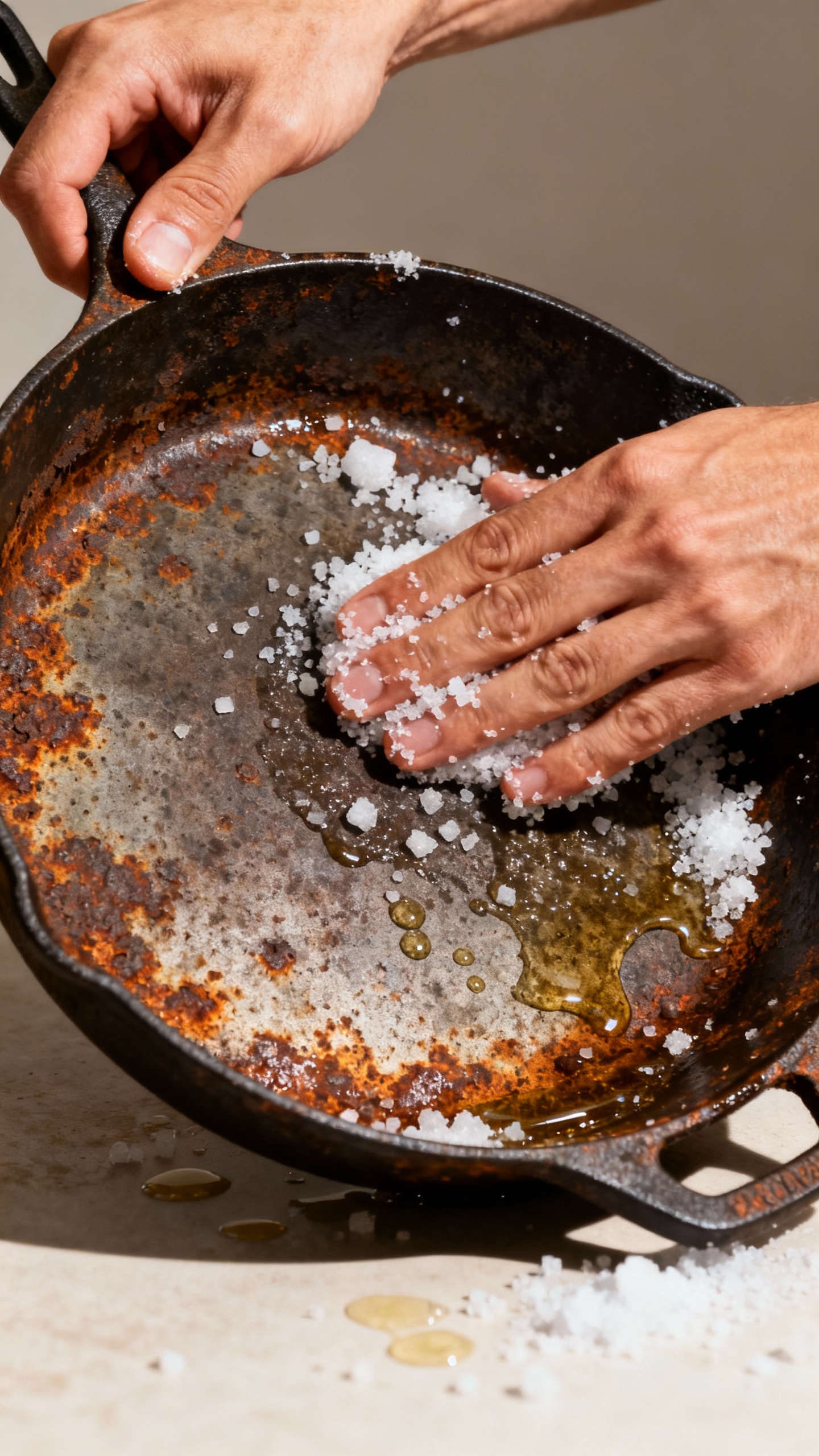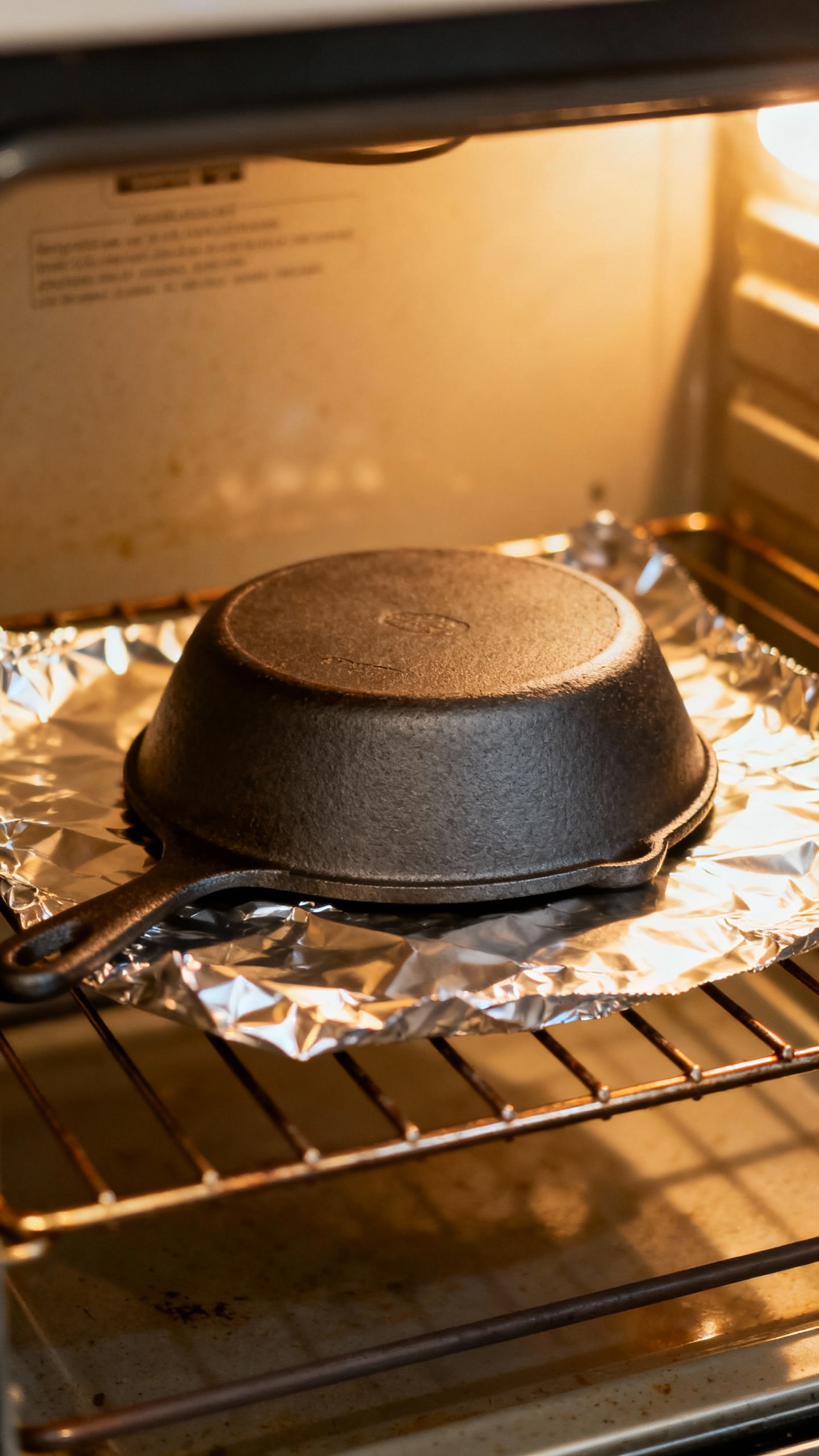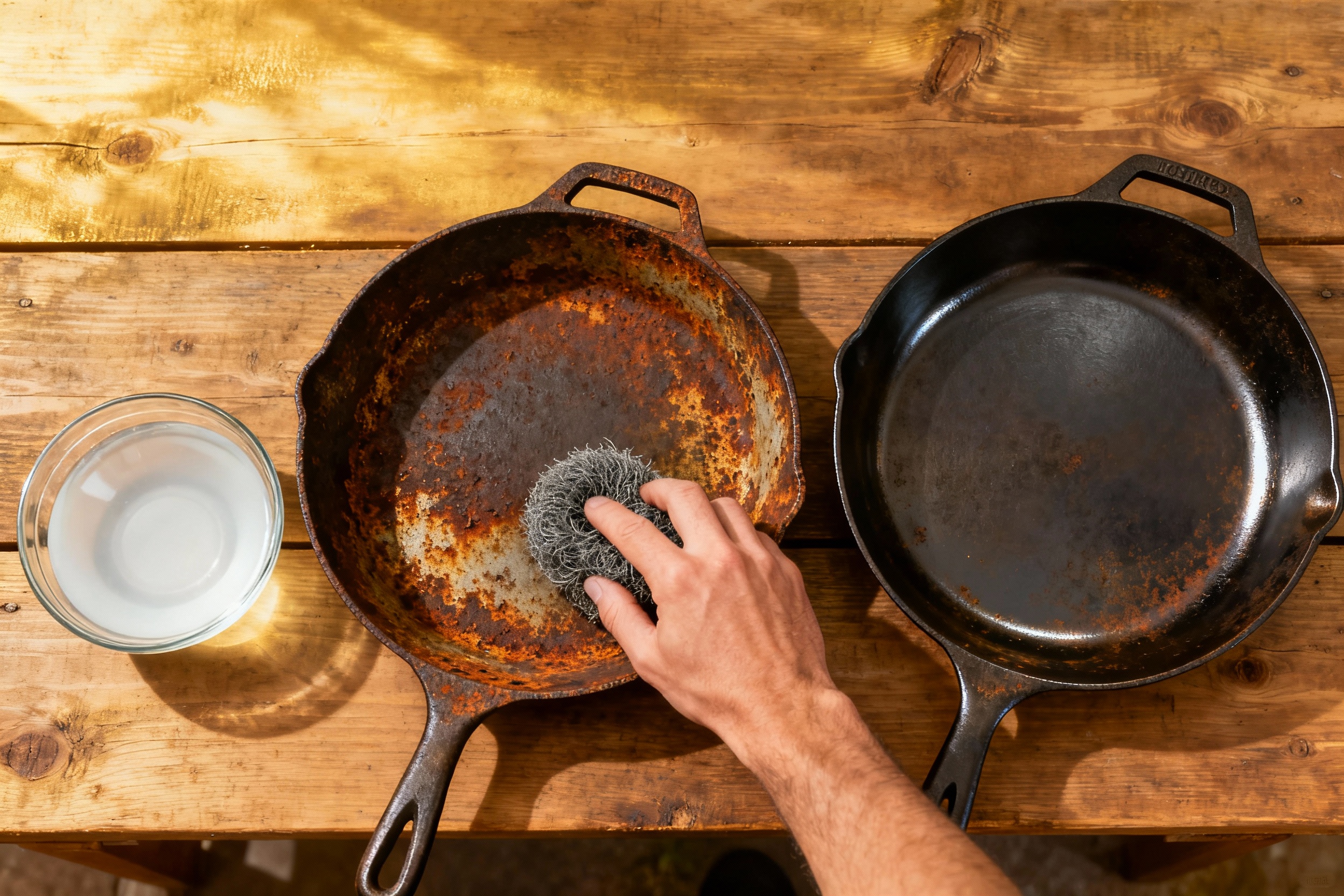Rust on your cast iron doesn’t mean you failed at cookware. It means water won a small, temporary battle. You can fix it.
In an hour or two, you’ll go from “uh oh” to “hello, glossy black skillet.” Let’s strip the rust, rebuild the seasoning, and get that pan back to searing glory.
First, decide: light rust or full-on orange disaster?

Not all rust is equal. A few orange freckles? Easy.
A solid crust that looks like Mars? Still fixable, but you’ll put in more elbow grease.
- Light surface rust: Patchy spots, minor discoloration. You’ll scrub and reseason.
- Moderate rust: Visible orange layer, but no pitting.
You’ll strip the seasoning and start fresh.
- Heavy rust/pitting: Texture feels rough with small pits. You’ll strip aggressively. It’ll still work great, IMO.
Gather your rust-busting kit
Keep it simple.
You don’t need a lab.
- Steel wool (000 or 00) or a chainmail scrubber
- Coarse salt (for abrasion)
- White vinegar
- Baking soda (optional, for neutralizing vinegar)
- Dish soap (yes, soap—calm down)
- Paper towels or clean rags
- Neutral oil with a high smoke point (grapeseed, canola, avocado)
- Oven or stovetop
- Aluminum foil (to catch drips)

Method A: Quick scrub for light rust
When you only see a few spots, don’t overcomplicate it.
- Scrub with salt and oil: Sprinkle a tablespoon of coarse salt into the pan. Add a teaspoon of oil. Use a paper towel or scrubber to grind the rust away.
Rinse and repeat.
- Soap and water: Wash with a tiny bit of dish soap and hot water. FYI, this won’t ruin anything; you’ll reseason afterward.
- Dry immediately: Put the pan on the stove over low heat for a few minutes until bone-dry.
- Oil lightly: Wipe on a thin film of oil while it’s warm, then wipe off excess. Done.
If it still looks dull, do a quick oven seasoning (details below).
Method B: Vinegar bath for stubborn or moderate rust
Vinegar dissolves rust like a champ, but treat it like a controlled burn.
- Mix a bath: Combine equal parts white vinegar and water in a container big enough to submerge the pan (or parts of it; rotate if needed).
- Soak briefly: Submerge for 15–30 minutes. Check every 10 minutes. Do not let it go hours. Vinegar can start eating base metal if you ignore it.
- Scrub: Remove and hit it with steel wool or a scrubber.
Most rust will slide off now.
- Neutralize (optional): Rinse, then wipe with a baking soda + water paste to calm any residual acid. Rinse again.
- Dry with heat: Place on a burner until completely dry. Gray, raw iron is normal at this stage.
What if rust still clings?
Go another short vinegar soak, but keep it under 15 minutes this round.
Scrub again. Repeat until the surface looks uniform and silver-gray.
Strip to bare metal (when you want a total reset)
If the seasoning looks patchy, sticky, or flaking, start fresh. You have options:
- Oven clean cycle: Put the pan upside down in your oven and run the self-clean function.
It incinerates old seasoning. Warning: smoke. Ventilate.
- Easy-Off or lye bath: Advanced route.
It dissolves polymerized oil without grinding the metal. Use gloves and caution.
- Electrolysis bath: The nerd method. It restores even severely rusted pans.
Amazing results, but it’s a project.
After stripping
You’ll see raw gray iron. It rusts instantly if you blink at it. Dry it hot on the stove and move straight to seasoning.
Seasoning: the glow-up
This is where the shine and nonstick magic return.
Think thin coats, high heat, patience.
- Preheat the pan: Warm it on low for 2–3 minutes to open the pores. Warming helps oil spread evenly.
- Apply a micro-thin coat of oil: Use a teaspoon of oil for a 10–12 inch skillet. Wipe it everywhere—inside, outside, handle, even the rim. Then wipe almost all of it off.
Dry-looking is right.
- Bake it: Place the pan upside down in a 450–500°F oven with foil on the lower rack to catch drips. Bake for 1 hour.
- Cool in the oven: Turn the oven off and let the pan cool inside for another hour.
- Repeat 2–3 times: Each layer builds hardness and sheen. The first coat may look matte; that’s normal.
What oil works best?
Use neutral, high-smoke oils like grapeseed, canola, or avocado.
Flaxseed polymerizes fast but can get brittle and flake if you go thick. IMO, grapeseed hits the sweet spot.
Daily care so rust never comes back
Rust happens when iron meets water and air. You can interrupt that romance.
- Clean smart: Wipe out crumbs with a paper towel.
For stuck bits, add a splash of hot water while the pan’s warm, scrape with a wooden spatula, then dry over heat.
- Keep it dry: Always finish on the stove for a minute or two. No moisture left = no rust.
- Oil lightly after use: When the pan is warm, add a few drops, wipe it to a satin sheen. Not greasy—just protected.
- Store with airflow: Slip a paper towel between stacked pans to absorb humidity.
- Avoid long soaks: Cast iron hates baths.
It’s a shower-only diva.
Fixing common hiccups
Stuff happens. Here’s how to course-correct fast.
My pan feels sticky after seasoning
You used too much oil or baked too low. Scrub lightly with hot water and a bit of soap, dry hot, and do one more ultra-thin coat at 475–500°F.
I see gray or dull patches
That spot needs more polymerized oil.
Do a quick one-coat seasoning just on that area, or cook something fatty (bacon therapy works).
Food still sticks
New seasoning needs mileage. Cook high-fat foods for a week. Avoid acidic sauces early.
Preheat the pan longer than you think—cast iron loves a good warm-up.
FAQs
Can I use steel wool without ruining my pan?
Yes. You remove rust and any loose seasoning, not the pan itself. Cast iron is tough.
After scrubbing, dry it thoroughly and reseason. The pan will thank you by living longer than we will.
Will soap strip my seasoning?
A little soap won’t hurt polymerized seasoning. It removes surface grease, not the hard, baked-on layer.
Just rinse, dry over heat, and oil. You’re fine.
How often should I reseason in the oven?
Do a full oven seasoning when the surface looks dull, sticky, or uneven—maybe every few months if you cook often. Daily light oiling after use prevents most issues.
Is rust dangerous to cook on?
A little rust isn’t toxic, but it tastes metallic and looks sad.
Scrub it off and reseason before cooking. If you spot rust mid-cook, finish the meal, then fix it after.
Can I save a pan with pitting?
Absolutely. Pits won’t hurt performance once you rebuild the seasoning.
It may not look showroom-perfect, but it’ll still sear like a champ.
What about enameled cast iron?
Different rules. Don’t season enamel. For rust on the rim or exposed edges, scrub gently, dry, and oil those bare spots.
Treat the enamel like a nonstick surface—no aggressive abrasives.
Conclusion
Rust happens. You’ll scrub, you’ll season, and your pan will come back stronger. Keep it dry, keep it lightly oiled, and cook on it often.
Before long, that skillet will develop the deep, glossy patina that makes cast iron legends—plus you’ll have bragging rights, which is honestly half the fun, FYI.


